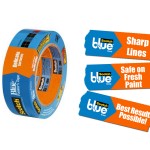 Very often when folks are at the lumber yard picking out wood for a particular home project, they choose Poplar. The reason is because it looks beautiful in its unstained, natural form and it’s very easy to work with. It also can be less expensive than woods like Cherry. And so, many homeowners pick up Poplar and then go to work trimming out their kitchen or living room or building a bookcase or two.
Very often when folks are at the lumber yard picking out wood for a particular home project, they choose Poplar. The reason is because it looks beautiful in its unstained, natural form and it’s very easy to work with. It also can be less expensive than woods like Cherry. And so, many homeowners pick up Poplar and then go to work trimming out their kitchen or living room or building a bookcase or two.
Now, Poplar is an absolutely perfect choice if your plans are to prime and paint your wood. Poplar is what we in the paint and stain industry refer to as a “paint-grade” wood. This means it’s perfectly suited for a paint application. That “paint-grade” classification also means that Poplar is not ideal for staining.
Poplar is technically a hardwood, but it’s one of the softer ones. This means it will take stain very unevenly. Stain soaks in and usually looks blotchy and lifeless, dull and generally not all that visually appealing.
Folks who choose Poplar with the intention of staining it to make it look like their more expensive Cherry cabinets face an uphill struggle. If that’s you, here are some tips that may help! (And just to be clear: these tips aren’t meant to be read as step-by-step instructions. For instructions, bring your wood to any RepcoLite or Port City Paints store and let us see what you’re doing and tell you the best way to get there. The tips below are just that–tips. Things to do and be aware of!)
TIP 1
If you’ve got the option, don’t choose Poplar if you’re going to stain the wood. I know this isn’t really a tip to help you stain your Poplar, but it’s still the best advice I can give to start with: don’t sink a lot of money into Poplar if you’re hoping for beautifully-stained end results. Oh, you can get a beautiful finish out of Poplar, but it’s not as easy as staining a wood that’s better-suited for stain, like Cherry, for example. So, if you’ve got the option, avoid Poplar for staining. If you don’t–if money’s an issue or if you’ve already purchased the Poplar–read on…
TIP 2
If you haven’t already picked up your wood, start by choosing the darker Poplar. Poplar generally will come in various shades: white, a darker yellow or almost grey tone, and then something much more green. Usually people resonate toward the white Poplar because it looks the cleanest. Unfortunately, the whiter the wood, the softer it usually is–and the softer it is, the more blotchy the stain will look. Darker Poplar generally has a denser grain and will take stain much better. If you have the option, choose the darker wood.
TIP 3
Save your scraps! When you work with the wood, save all the cut-off scraps. Use these as samples when it comes time to test your stain (or when you need a stain match). One of the key mistakes when staining wood is failing to test your stain ahead of time. You don’t want to apply stain to your trim only to find out then that the stain or your system for applying it doesn’t get you the color you want. Instead, test the color and the method on your scraps until you’re comfortable with the process and are sure that the stain color is correct.
TIP 4
Bring those scraps into RepcoLite for a custom stain match. Now, you may be tempted to balk at this step, but if you’re working with Poplar, this is a no-brainer. Sure, you could pick a wood stain off a shelf in some store and hope for the best, but why? If you bring a sample of your wood and a sample of the color you want to RepcoLite, Port City Paints or Snyder Paints, we’ll create a custom stain for you and also work out the process that’s necessary to get you there. THIS IS ESSENTIAL! Any store can give you a stain, but it takes a place with some expertise to be able to explain and walk you through the actual process of applying it–the various products you might need, the steps you should take and the time you should allow between each one.
On some easy-to-stain woods this may not be as critical, but with Poplar, there are a lot of variables–a great number of different application techniques that can be employed to get your color. We’ll work with your wood, figure out what must be done, and then give you the details so you can produce the correct look in your home. So bring the scraps to us and let us help.
TIP 5
Be aware of a product RepcoLite manufacturers called “Softwood Sealer”. This is a wood conditioner that is applied before you stain and which serves to seal up the porous wood to minimize or eliminate the blotchy appearance. This sealer is applied with a brush and then wiped off with a rag. It can be left to dry anywhere from 15 minutes to 24 hours depending on how porous the wood is and what type of look you desire. If you have your stain custom-matched by RepcoLite, we’ll tell you how long to let this sealer dry before you stain. If you don’t, and you’re flying solo on this project, make sure you use those sample boards from step 3!
TIP 6
Purchase a wiping stain or a gel stain–not a penetrating stain. Wiping stains will give you a little more control over your color and penetrating stains will simply soak in too quickly and too deeply (even with the softwood sealer), producing a blotchy end result.
TIP 7
Finally, (to repeat): sample, sample, sample! Use those cut-off scraps from step 3 and test your stain until you’re comfortable with the process and the method.
Staining Poplar isn’t easy–the nature of the wood is constantly working against you, making it tough to achieve a beautifully-stained finish. But, with that said, you can still accomplish a great end result. It just takes a little more work and a little more know-how, but it can be done! And once more, let me encourage you to stop out at any RepcoLite, Port City Paints or Snyder Paints store (Indiana) for expert advice! We’ve been helping people do this for years–let us help you!



 “My name’s Dan and I’m a recovering Prep Work Skipper.”
“My name’s Dan and I’m a recovering Prep Work Skipper.” Has this ever happened to you: you walk into the paint store for paint and then spend the next three days or a week or more agonizing over the color chips you brought home? You hold them up to every piece of furniture in the room. You lay them on your carpet, on your end table. You try to picture them large scale–covering your walls. You debate between one shade and a slightly darker shade. And then, finally, after all the debate and analysis and agony, you pick the perfect colors.
Has this ever happened to you: you walk into the paint store for paint and then spend the next three days or a week or more agonizing over the color chips you brought home? You hold them up to every piece of furniture in the room. You lay them on your carpet, on your end table. You try to picture them large scale–covering your walls. You debate between one shade and a slightly darker shade. And then, finally, after all the debate and analysis and agony, you pick the perfect colors. Most folks forget about their ceilings when it comes time to paint and as a result, most ceilings are forgettable.
Most folks forget about their ceilings when it comes time to paint and as a result, most ceilings are forgettable. However, there’s something very interesting to realize here: many folks understand this concept and they figure that painting those ceilings white will really serve to open the room up. However, think about this: if you’ve got a medium toned color on your walls, no matter what shade, a white on the ceiling can often produce a very sharp distinction between the walls and the ceiling. This sharp distinction, this high contrast between walls and ceiling, can often lead people to conclude that their wall color doesn’t work–that it needs to be repainted.
However, there’s something very interesting to realize here: many folks understand this concept and they figure that painting those ceilings white will really serve to open the room up. However, think about this: if you’ve got a medium toned color on your walls, no matter what shade, a white on the ceiling can often produce a very sharp distinction between the walls and the ceiling. This sharp distinction, this high contrast between walls and ceiling, can often lead people to conclude that their wall color doesn’t work–that it needs to be repainted. Imagine the same room with a white ceiling. In fact, you don’t have to imagine it, look at the picture below. That’s the same room with a standard white on the ceiling and the whole mood of the room changes. The stark white on the ceiling makes the green on the walls feel harsh. Many times, folks would paint a room like this, think they love that green, only to be back later for new paint because the color’s just too strong on the walls.
Imagine the same room with a white ceiling. In fact, you don’t have to imagine it, look at the picture below. That’s the same room with a standard white on the ceiling and the whole mood of the room changes. The stark white on the ceiling makes the green on the walls feel harsh. Many times, folks would paint a room like this, think they love that green, only to be back later for new paint because the color’s just too strong on the walls.
 I’m cheap. I’ve probably written that before, but that doesn’t matter. I’m so cheap, it’s legitimate to write it again. But that cheapness has it’s limits.
I’m cheap. I’ve probably written that before, but that doesn’t matter. I’m so cheap, it’s legitimate to write it again. But that cheapness has it’s limits.
 Every now and again, a new product enters the home decorating field and changes the way everything is done. Today I want to very briefly highlight one such product: 3M’s Delicate Surface Masking Tape.
Every now and again, a new product enters the home decorating field and changes the way everything is done. Today I want to very briefly highlight one such product: 3M’s Delicate Surface Masking Tape.
 The other day, I received a call from the Manager at our Jenison RepcoLite, John Boomsma (see inset). He had just run into a crazy situation in the store and figured I could make use of the information on our blog.
The other day, I received a call from the Manager at our Jenison RepcoLite, John Boomsma (see inset). He had just run into a crazy situation in the store and figured I could make use of the information on our blog.